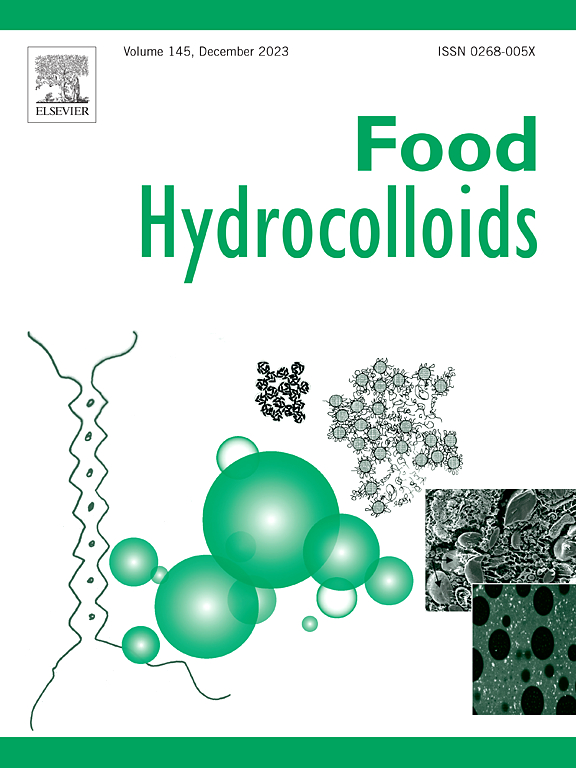Dose-effect relationship and molecular mechanism of cellulose nanocrystals from green tea residue on the gel behavior of pea protein-derived amyloid fibrils
IF 11
1区 农林科学
Q1 CHEMISTRY, APPLIED
引用次数: 0
Abstract
In this paper, the dose-effect relationship and molecular mechanism of tea residue derived cellulose nanocrystals (CNC) to improve the gel behavior of pea protein-derived amyloid fibrils (PAFs) were studied. The results showed that the gel strength and water holding capacity of PAFs+1.5 % CNC gel increased respectively by 21.40 % and 37.50 % compared with PAFs gel (p < 0.05). At the same time, CNC promoted the aggregation of PAFs to form protein aggregates with large size and uniform distribution. In addition, compared with PAFs gel, the relative content of α-helix in PAFs+1.5 % CNC gel decreased by 14.90 % (p < 0.05), while the relative content of β-sheet increased by 6.50 % (p < 0.05). With the increase of CNC addition, the ionic bonds, hydrogen bonds and disulfide bonds were strengthened in the PAFs-based composite gel, while the hydrophobic interactions were weakened. Gradient CNC could change the aggregation behavior and multi-scale structure of PAFs molecules to different degrees, promote the exposure of functional groups and strengthen the interaction between molecules, and realize the targeted regulation of PAFs-based gel strength and water holding capacity. This study provided a theoretical reference for the wide application of PAFs-CNC composite gel system in functional protein substrates and food ingredients.

求助全文
约1分钟内获得全文
求助全文
来源期刊

Food Hydrocolloids
工程技术-食品科技
CiteScore
19.90
自引率
14.00%
发文量
871
审稿时长
37 days
期刊介绍:
Food Hydrocolloids publishes original and innovative research focused on the characterization, functional properties, and applications of hydrocolloid materials used in food products. These hydrocolloids, defined as polysaccharides and proteins of commercial importance, are added to control aspects such as texture, stability, rheology, and sensory properties. The research's primary emphasis should be on the hydrocolloids themselves, with thorough descriptions of their source, nature, and physicochemical characteristics. Manuscripts are expected to clearly outline specific aims and objectives, include a fundamental discussion of research findings at the molecular level, and address the significance of the results. Studies on hydrocolloids in complex formulations should concentrate on their overall properties and mechanisms of action, while simple formulation development studies may not be considered for publication.
The main areas of interest are:
-Chemical and physicochemical characterisation
Thermal properties including glass transitions and conformational changes-
Rheological properties including viscosity, viscoelastic properties and gelation behaviour-
The influence on organoleptic properties-
Interfacial properties including stabilisation of dispersions, emulsions and foams-
Film forming properties with application to edible films and active packaging-
Encapsulation and controlled release of active compounds-
The influence on health including their role as dietary fibre-
Manipulation of hydrocolloid structure and functionality through chemical, biochemical and physical processes-
New hydrocolloids and hydrocolloid sources of commercial potential.
The Journal also publishes Review articles that provide an overview of the latest developments in topics of specific interest to researchers in this field of activity.
 求助内容:
求助内容: 应助结果提醒方式:
应助结果提醒方式:


